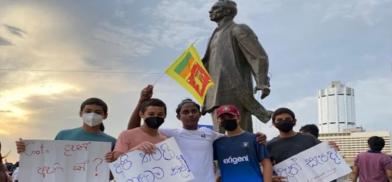Why was the Aragalaya movement in Sri Lanka personal to me?
What had started as unrest – in response to decades of failed promises, nepotism – had been reduced to a mob seeking revenge. The question remains on how to preserve the spirit of the former whilst recognising the nature of the latter.

The movement known as the Aragalaya ("struggle" in Sinhala) that overthrew a democratically elected president in Sri Lanka is now over a year old. And I, also a year older and wiser, can see that protest not only as a landmark in my personal history but more importantly an unappreciated tool for a smoothly functioning democracy.
The Aragalaya was a first because the protest was so magnetic and spontaneous that in a country with a civil war history and a recent past of minority manipulation, the uprising cut through all divisions and co-opted everyone.
What I initially saw as an interruption to my O-Level preparation, has evolved to become perhaps my most cherished memory of growing up in Sri Lanka, my mother’s homeland.
Neighbourhood protest
On a balmy tropical evening in March 2021, my mother, my younger sister, our dog, and I joined a small group of protestors gathered around our neighbourhood pizzeria. The plan was to carry our placards, sing songs of protest and return in time for dinner.
We were headed to a larger peaceful protest that had gathered close to home. As we walked along the lanes in our area, we were caught unaware by the number of people who joined in. Street vendors, cyclists, mothers with children, and even a priest, all began walking with us. What started as a motley group of ten had turned into a crowd of a hundred by the time we reached a main intersection.
At that point, the police stopped us and politely asked us to return. This was quite unlike the police of the past. They smiled, they seemed to understand and even empathise, they didn’t carry batons or wear helmets. In retrospect this was the first sign that something deep was possibly stirring in the country. Why is this collective memory so important to retain and refresh?
By the end of 2021, Sri Lanka's foreign debt had risen to over 100 per cent of GDP. To cover government spending, the Central Bank printed money and stubbornly refused to accept the IMF plan or its recommendations. Inevitably inflation became uncontrollable, and the country had barely any fuel, gas, grain, pulses or life-saving drugs. With a family at the helm — the President, Finance Minister, and Prime Minister were brothers — public outrage was easily directed. By July, in what was its most famous moment – when the President’s residence was breached -- the Aragalaya had sent the President to exile and forced the Prime Minister and the Foreign Minister to resign.
It is simple and accurate to say that desperation brought these people together. It is somewhat more complicated for a democracy to admit that its executive pillars of the judiciary, the police, and the military not only let the Aragalaya gather force but also, in places, supported the cause for regime change; and before we hand any credit to the executive, I believe their support was inevitable. The only people not supporting the protest were the majority in Parliament.
Anti-establishment
I had heard stories about how my grandmother Kavita Nagpal founded a street theatre company in India, where my father is from. The theatre company performed anti-establishment plays, skits, and musicals all around the country. She remained, until her passing in 2021, a revolutionary at heart, and was always on the lookout for any protest against a repressive state.
As The Hindu newspaper put it, she was not only a theatre director but also a woman journalist who broke new ground by getting her own syndicated column across various newspapers. If she was in Sri Lanka, I have no doubt she would have dragged herself in a wheelchair across the capital with every protest.
In modern democracies, where fact and fiction often blend into one, mass protests like the Aragalaya or the farmer protest in India, remain an authentic medium for being heard and heeded. So maybe my grandmother had an important point to make.
Perhaps my grandmother, who was a journalist, spotted early on that the democratic process can lead to sub-optimal outcomes and that it is necessary to continue pushing the boundaries of the state to keep them (keep those in power) on their toes.
I saw the Aragalaya in its uncontaminated, non-violent form, and then again, on the 9th of May 2023, when people started to burn the homes of government ministers. I saw the same movement being co-opted by the revolutionary left and the anarchist right.
What had started as unrest – in response to decades of failed promises, nepotism – had been reduced to a mob seeking revenge. The question remains on how to preserve the spirit of the former whilst recognising the nature of the latter.
For me the Aragalaya was personal. Maybe I didn’t understand it at the time, but my mother’s daily disciplined, single-minded commitment to the protest went a long way toward explaining my grandmother's life.
(The author is a high school student in Colombo, Sri Lanka who developed and implemented solutions for the economic crisis in his country by placing land titles on a blockchain server, an impenetrable digital file cabinet, and improving collateral accessibility for the poor. Rumi has delivered a TEDx talk on his blockchain-based solution. Views are personal. By special arrangement with Sapan News )










Post a Comment